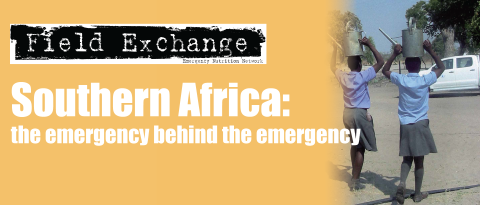Postscript to 'Infant feeding in tsunami affected villages in India'

Dr Bethou is a paediatrician currently based at the Mahatma Gandhi Medical College and Research Institute, Pondicherry, India and was one of the researchers in the study just summarised. Here he expands on his research findings.
Most of the needs assessment and interventions post-tsunami related to mortality census, rehabilitation (including housing), and providing new fibre boats. We were not aware of any need assessments at any stage relating to infant and young child feeding or specific interventions to support breastfeeding during the emergency response, either by local staff or international organisations. Apart from the immediate supply of food packets for a week or two after the tsunami, there was no significant infant feeding intervention. After each interview during our research, we took the opportunity to brief the mother regarding best practices with regard to breastfeeding and the need to support these, especially during emergencies.
Food supplies for children (free bread and milk routinely given out at schools) continued in the acute phase of the response. Temporary community kitchens were established in places like schools. These provided food to adults that was shared with their children. However children were deprived of their staple diet of fish for between 3- 4 months as their parents feared that sea fish would be contaminated post-Tsunami.
During the emergency, the healthcare facilities consisted of mobile health camps organised by the Government and NGOs. Most mothers had to seek help to manage their children's diarrhoea. However ORS packets were provided in abundance. A few mothers had seen their neighbours using ORS and just followed what they had seen.
No one knew exactly who supplied the free BMS. Each day after the tsunami, packages that included BMS and feeding bottles, among other things, just kept appearing. They were provided by the Government, NGOs and individuals in blanket distributions with no targeting criteria. Determining the exact origin of BMS was difficult in our study as the survey was carried out almost one year after the tsunami.
We describe 'poor quality breastmilk substitutes' in the research paper. By this we meant that the BMS were supplied in polythene packs that were often damaged on opening. This meant that the powder absorbed more moisture and was not dry. As a result the adults often used it for preparing coffee or tea, rather than feeding the children. The labels simply read 'milk powder' with an ISI mark, but there was no date of manufacture or expiry date.
Out of the hundred mothers we interviewed, whose children ranged in age from 0-4 years, 30 mothers had fed their children with food or fluids other than breast milk within the first six months of life. These 30 mothers described that they had started feeding their children with commercial infant formula or cow's milk before six months due to "insufficient milk". Bottles were the predominant container used for feeding not only infant formula, but also semi-solids/other foods and drinks. The prevalent practice of formula feeding pre - Tsunami in these coastal villages came as a surprise to the researchers. Generally, it is believed that breastfeeding is common among the rural Indian population and that they are not sufficiently wealthy to afford commercial formula. This survey also revealed how media advertisements can mislead mothers and how emulating the infant feeding practices of neighbours can lead to a chain reaction in the community. However, as pre-Tsunami data on infant feeding and anthropometry were lacking, it was difficult to assess the impact of the Tsunami objectively.
The research found that 67% of women felt that breastfeeding was affected by the Tsunami. Most mothers in the villages studied were under stress and were in the process of frequent shifting between their homes near the seashore and the temporary relief shelters due to rumours of a repeat Tsunami. Therefore they did not eat well and felt they could not breastfeed their babies properly. In particular, they could not breastfeed as frequently or as peacefully as usual. However these difficulties were experienced for only a few weeks, after which they were able to breastfeed normally. Older infants were fed as usual. The focus group discussions and interviews highlighted how infants with no mothers were fed with cow's milk, and how "immediate remarriages occurred in families where the mother died in order to take care of children, especially infants".
One final comment and important consideration on conducting assessment and research in such contexts: during the study some people did not want to recollect experiences as it brought back painful memories of the disaster. Afew even broke down during the interviews. Also, a few adults were reluctant to provide information as the relief work had not been carried out to their satisfaction and they expected monetary benefit (as relief) after the interviews. If this is the situation fully one year on from the emergency, immediate assessment after the emergency may not have been feasible or at least severely constrained. Finally, it is important to state that without the help of local volunteers we would not have completed the survey. Their presence was essential for establishing a rapport with those affected by this disaster.
For further information, contact Dr Bethou Adhisivam, email: adhisivam1975@yahoo.co.uk
Imported from FEX website


